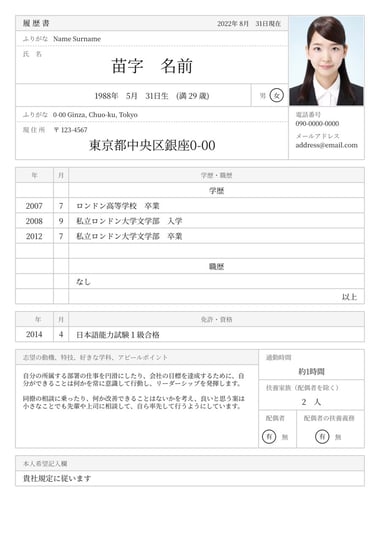What is an ATS-friendly resume?
An applicant tracking system (ATS) is software that recruiters and companies use to vet incoming resumes. Once you have submitted an application, the program scans your resume for useful information. Based on this, the software ranks your application by how well it meets the criteria of the job vacancy. Only the top-ranking resumes make it past the software.
To use the software, recruiters input the job description, skills, and experience they expect from prime candidates. The ATS program uses this information to create a profile of the perfect candidate for the role. The software uses this profile as the bar when reviewing applications. That means your rank position will depend on how well you match the ideal candidate profile.
Why ATS-friendly resumes matter
Creating an ATS-friendly resume is vital to your success. Research suggests that 75% of recruiters now use this software when running hiring campaigns.
Passing the initial ATS scanner is often the first step of the hiring process. If your resume does not meet the criteria set out by the software, your application may be rejected before a hiring manager even looks at it.

How do I make an ATS-approved resume?
Before you can make an ATS-approved resume, you need to understand how the software works. Let’s take a look at the main points that you need to know about this type of program.
Understanding how ATS works
ATS software reviews extracts of your resume. These include your basic information (such as your contact details), your summary, your work experience, and your education. Additionally, the system identifies predefined keywords that are listed within the job criteria. The ranking system means that only the most suitable resumes pass the test and make it to the next stage.
It’s important to note that you cannot know exactly how an ATS system delivers its ranking. However, there are ways in which you can boost your chances of success. Optimizing your resume to meet the needs of the job posting will give you a higher chance of passing the ATS.
How ATS systems scan and rank resumes
ATS software scans various parts of your resume to determine how well you meet the role's criteria. It’s worth understanding which parts of your application the program will specifically look at.
The main elements to keep in mind are, as follows:
- The format of your resume
- The file type of your resume
- The specific keywords included
- The headings and subheadings
Ensuring that you use a standardized layout and style is vital. ATS systems don’t like surprises. Opting for an overly “creative” design could confuse the system, leading to an unfair rejection. Equally, you need to make sure that your resume is easy to read for the software.
Key components of an ATS resume template

Now that you understand how an ATS program works, let’s talk about how you can beat the bots. The power is in your hands. If you want to create an ATS-friendly resume, here are some of the important things that you should keep in mind.
Selecting the right file type
It’s not just about your resume’s content. Most ATS programs require you to submit your resume as a .doc (Microsoft Word), .docx, or .txt file. These systems cannot read PDF formats. You should avoid using this type of file when you are applying for jobs, unless the description states otherwise.
Optimizing resume with keywords
The words you include in your resume matter. ATS programs scan your resume for predetermined words and phrases. If you want to give your resume the best chance of passing the test, you should incorporate as many of the chosen keywords into the document.
Be sure to use the exact terminology in the original job advert while steering clear of synonyms.
- "Project management" instead of "Leading projects"
- "Customer relationship management (CRM)" instead of "Managing client interactions"
- "Sales pipeline" instead of "Sales process"
- "Data analysis" instead of "Analyzing information"
- "Budget management" instead of "Handling finances"
- "Content creation" instead of "Writing materials"
- "Search engine optimization (SEO)" instead of "Improving website visibility"
- "Team collaboration" instead of "Working with others"
- "Product development" instead of "Creating products"
- "Stakeholder communication" instead of "Talking to clients or partners"
Don’t shoehorn words into your resume!
You need to make sure that your resume flows well. For that reason, it’s important to include the keywords in the document naturally. Ensure that each word you use makes logical sense.
Designing & structuring your resume for ATS
If you want to make sure that your resume gets past the ATS, you need to have a simple design. It’s important to structure your resume in the right way for the software. Not sure where to start? Here are some of the tactics you can use when laying out your resume.
Formatting for ATS compatibility
Use a standardized format so the system understands your resume. The three main formats you can use are a reverse chronological order, a functional layout, and a combination (or hybrid) layout. Choose one of these to ensure that the ATS program can easily scan your resume.
Avoiding common pitfalls
We all make mistakes. But if you want to ensure that your resume gets past the ATS system, you need to avoid them.
Here are some of the common errors you should avoid:
- Complicated designs: You need to make sure that the ATS program can quickly scan your resume. If you use a complex layout or design, it could hinder this process.
- Including images: Avoid including images and graphics for no reason. Often enough, the ATS program cannot read or scan these elements.
- Poor spacing: Try not to cram too much information onto the page. Make sure you have 1-inch spacing around the margins of your resume. White space is your friend.
- The wrong font: It’s important to choose an appropriate font for your resume. Classic typefaces such as Arial, Helvetica, and Times New Roman are your best bet.
- Incorrect headings: The ATS system locates various parts of your resume by the headings you use. Including incorrect headings will land you in trouble here.
When reviewing your resume, make sure you haven’t made any of these mistakes. Above all else, you should ensure your ATS-friendly resume has a standard look and structure.
Essential resume sections for ATS
While we’re on the subject of structure, make sure you get it right. As a general rule, an ATS-compliant resume needs to include the following sections:
- The resume header (featuring your name and contact details)
- The resume summary (aka profile or personal statement)
- The employment history section
- The resume skills section
- The education section

You might be tempted to shake things up and move these sections around. Don’t make that error. Instead, use the above layout and label each of the sections with the above headers.
Ensure there’s a clear hierarchy!
Hierarchy is important when you’re creating an ATS-friendly resume. You need to make sure that your application has an obvious hierarchy of importance. Put the most pertinent details toward the top of the pageant, and then work your way down in that fashion.
If you choose not to use a one-column resume, a two-column layout can help by placing less important information—such as contact details, hobbies, and interests to the side.
Keep your design clean and simple
Finally, let’s address your design. Choosing anything “out of the box” won’t get you very far. Instead, you need to opt for a clean and simple design. This strategic approach will help boost your resume’s readability, which will allow it to pass the ATS software with sheer ease.
Need some help to perfect this art? Take a look at our ATS resume templates now. Choose from Simple, Creative, Modern, or Professional designs.
Testing your resume for ATS compliance
You can create a flawless application with our resume builder. When you have done that, you might want to check how ATS-friendly it is. Our templates have been designed to comply with the needs of modern-day ATS software, giving you an immediate competitive edge.
As we have mentioned, the vast majority of businesses and recruiters now use ATS programs. Ensuring that your you have an ats-compliant resume fit for purpose will instantly increase your chances of landing an interview. Take the time to check your ATS score before submitting your next application. That way, you can be certain that your resume will hit the mark.


































